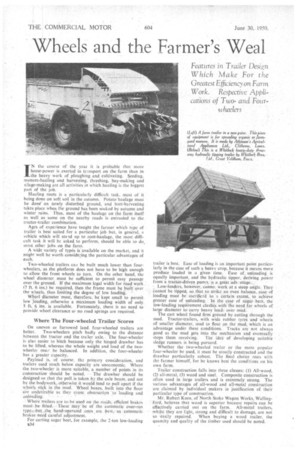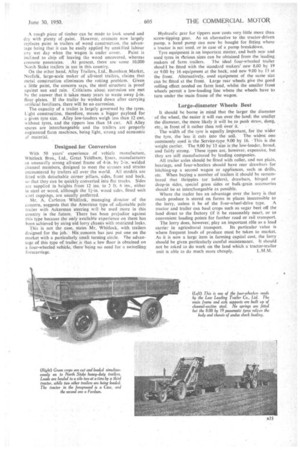Wheels and the Farmer's Weal
Page 76

Page 77

If you've noticed an error in this article please click here to report it so we can fix it.
Features in Trailer Design Which Make. For the Greatest Efficiency on Farm Work. Respective Appli cat1ioiis of Two;and Fourwheelers IN the course of the year it is probable that more horse-power is exerted in transport on the farm than in the heavy work of ploughing and cultivating. Seeding. manure-hauling and harvesting, threshing, hay-making and silage-making are all activities in which hauling is the biggest part of the job.
Hauling roots is a particularly difficult task, most of it being done on soft soil in the autumn. Potato haulage must be done on newly disturbed ground, and beet-harvesting takes place when the ground has been soaked by autumn and winter rains. Thus, most of the haulage on the farm itself as well as some on the nearby roads is entrusted to the tractor-trailer combination.
AgeS of experience have taught the farmer which type of trailer is best suited for a particular job but. in general, a vehicle which will staid up to root-haulage, the most difficult task it will be asked to perform, should be able to do, most other jobs on the farm.
A wide variety of types is available on the market, and it might well be worth considering the particular advantages of -each.
Two-wheeled trailers caa be built much lower than fourwheelers, as the platform does not have to be high enough to allow the front wheels to turn. On the other hand, the wheel diameter must be sufficient to permit easy passage over the ground. If the maximum legal width for road work (7 ft. 6 ins.) be required, then the frame must be built over the wheels, thus limiting the degree of low loading. Wheel diameter must, therefore, be kept small to permit low 'loading, otherwise a maximum loading width of only 5 ft 6 ins, is available. Fortunately, there is no need to provide wheel clearance as no road springs are required.
Where The Four-wheeled Trailer Scores
On uneven or furrowed land. four-wheeled trailers are better. Two-wheelers pitch badly owing to the distance between the tractor and the trailer axle.The four-wheeler is also easier to hitch because only the hinged drawbar has to be lifted, whereas the whole weight and load of the twowheeler mua be balanced. In addition, the four-wheeler has a greater capacity.
Payload is, of course, the primary consideration, and trailers used much below capacity are uneconomic. Where the two-wheeler is more suitable, a number of points in its
construction should be noted. The drawbar should he designedso that the pull is taken by the axle beam; and not by the bodywork, otherwise it would-tend to pull apart if the wheels. stick in the mud. Wheel boxes, built into the floor are undesirable as they cause obstruction to loading and
anlOading. •
Where trailers are to be used on the rids, efficient brakes must be, fitted. -These may•be of the automatic over-run typei, but ..the. nand-operated ,ones are tiest,-9.s.-automatic brakes need careful adjustment.
For carting sugar beet, for example, the 2-ton low-loading 934 trailer is best. Ease of loading is an important point particularly in the case of such a heavy crop, because it means more produce loaded in a given time. Ease of unloading is equally important, and the hydraulic tipper, deriving power from a tractor-driven pumi. is a great:adv Adage. .
Low-loaders, however, canno work at a steep angle: They -Cannot be tipped. so. that to strike an even balance, -ease of loading must be' sacrificed to .a certain extent, to achieve greater ease of unloading. In the case of sugar beet, the low-loading reqdirement clashes with the need for wheels of large diameter to carry heavy load,: over mud.
The cart wheel found firm ground by cutting through the mud. Tractor-trailers, with wide rubber tyres and wheels of smaller diameter, tend to float on the mud, which is an advantage under these conditions. Tracks are not always good as. the mud gets into the mechanism and eventually stops them revolving. The idea of developing suitable sledge runners is being pursued. • Whether the two-wheeled trailer or the more popular four-wheeler be used, it must be stoutly constructed and the drawbar particularly robust. The final choice rests with the farmer himself, for he knows best the conditions on his own farm.
Trailer construction falls into three classes: (1) All-wood, (2) all-metal, (3) wood and steel. Composite construction is often used in large trailers and is extremely strong. The various advantages of all-wood and all-metal construction are claimed by individual makers in justification of their particular type of construction.
Mr. Robert Keen, of North Stoke Wagon Works, Walling' -fOrd, believes that wood is superior because repairs can be effectively carried out on the farm. All-metal trailers, -whilst they are light, strong and difficult to damage, are not so -easily repaired. When buying a wood trailer, the quantity and quality of the timber used should be noted. A rough piece of timber can be made to look sound and dry with plenty of paint. However, creosote now largely replaces paint in trailers of wood construction, the advantage being that it can be easily applied by unskilled labour any wet day when the wagon is under cover. Paint is inclined to chip off leaving the wood uncovered, whereas
creosote penetrates. At present, there are some 10,000 North Stoke trailers in use in this country.
On the other hand, Alley Trailers, Ltd., Burnh'arn Market, Norfolk, large-scale maker of all-steel trailers, claims that metal construction eliminates the rotting problem. Given a little paint, the concern says, the steel structure is proof against sun and rain. Criticisms about corrosion are met hy the answer that it takes many years to waste away Fin. floor plates. If the trailer be washed down after carrying artificial fertilizers, there will be no corrosion.
The capacity of a trailer is largely governed by the tyres. Light construction, therefore, means a bigger payload for a given tyre size. Alley low-loaders weigh less than 12 cwt. without tyres, and the tippers less than 14 cwt. All Alley spares are interchangeable and the trailers are properly engineered farm machines, being light, strong and economic of material.
Designed for Conversion With 50 years' experience of vehicle manufacture, Whitlock Bros., Ltd., Great Yeldham, Essex, manufactures an unusually strong all-steel frame of 4-in. by 2-in, welded channel members, designed to meet the stresses and strains encountered by trailers all over the world. All models are fitted with detachable corner pillars, sides., front and back, so that they can be quickly converted into flat trucks. Sides ace supplied in heights from 12 ins. to 2 ft. 6 ins., either in steel or wood, although the 11-in. wood sides, fitted with steel cappings, are uSually preferred.
Mr. A. Carleton Whitlock, managing director of the concern, suggests that the American type of adjustable pale trailer with Ackerman steering willbe used more in this country in the future. There has been prejudice against this type because the Only available experience on them has been achieved by using old lorry chassis with restricted locks.
This is not the case, states Mr. Whitlock, with trailers designed for the job. His concern has just put one on the market with a particularly small turning circle.The advantage of this type of trailer is that a low floor is obtained on a four-wheeled vehicle, there being no need for a swivelling fo reca rriage. Hydraulic gear for tippers now costs very little more than screw-tipping gear. As an alternative to the tractor-driven pump, a hand pump can now be bought for fitting where a tractor is not used, or in case of a pump breakdown.
Tyre equipment is an important matter, and both new and used tyres in Various sizes can be obtained from the leading
makers of farm trailers. The ideal four-wheeled trailer shouli befitted with the standard makers' new 8.00 by 19 Or 9.00 by 16 equipment at the back; and new 9.00 by 13 at the front. Alternatively, used equipment of the same size can be fitted at the front. Large rear wheels give the good rolling effect needed on farm land, whilst the smaller front wheels permit a low-loading line where the wheels have to turn under the main frame of the wagon.
Large-diameter WheelsBest It should be borne in mind that the larger the diameter of the wheel, the easier it will run over the land; the smaller the diameter, the more likely it will be to push straw, dung,
etc., in front of it rather than roll Over it. '
. The width of the tyre is equally important, for the wider the tyre, the less it cuts into the soil. The widest one commonly used is the Service-type 9.00 by 16. --This is the weight carrier.' The 9.00 by.13 size-is-the low-loader, broad, and fairly strong. These types are, however, expensive, but they are still manufactured by leading companies_ All trailer axles should be fitted with roller, and not plain, bearings, and four-wheelers should have rear drawbars for hitching-up a second wagon or appliances, such as drills, etc. When buying a number of trailers it should be remembered that thripples (or ladders), drawbars, hinged or drop-in sides, special grass sides or bulk-grain accessories should be as interchangeable as possible.
Where the trailer has an advantage over the lorry is that much produce is stored on farms in places inaccessible to the lorry, unless it be of the four-wheel-drive type. A tractor and trailer can haul crops such as sugar beet off the land direct to the factory (if it be reasonably near), or to convenient loading points for further road or rail transport.
The lorry does, however; play an important role as a load
carrier in agricultural transport. Its particular value is where frequent loads of produce must be taken to market. As it is now a large item in farming capital cost, the lorry should be given particularly careful maintenance. It should not be asked to do work on the land which a tractor-trailer
unit is able to do much more cheaply. L.M.M.




























































































































